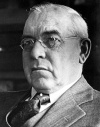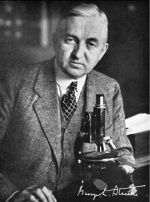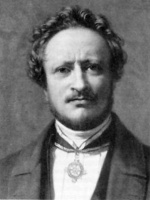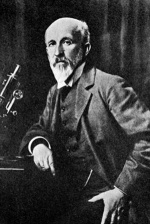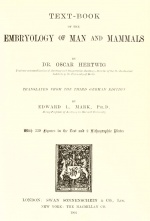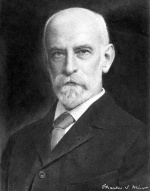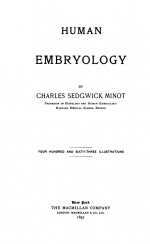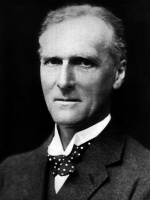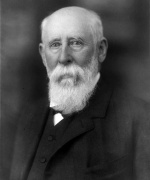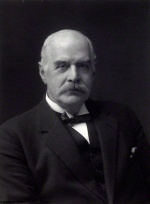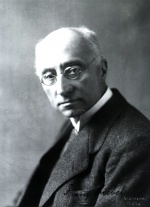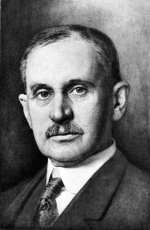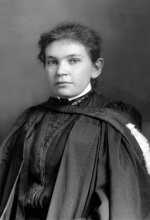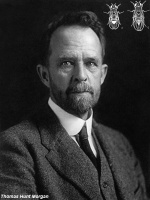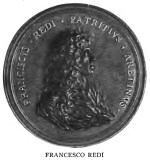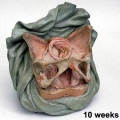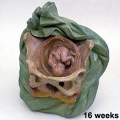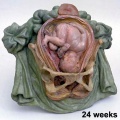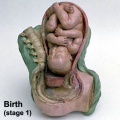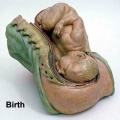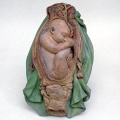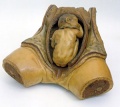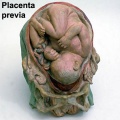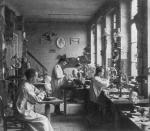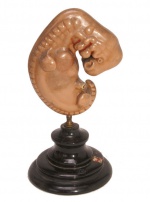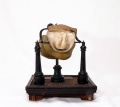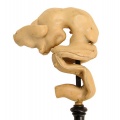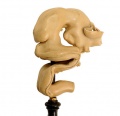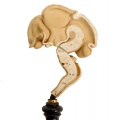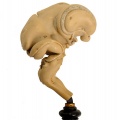Embryology History
| Embryology - 24 Apr 2024 |
|---|
| Google Translate - select your language from the list shown below (this will open a new external page) |
|
العربية | català | 中文 | 中國傳統的 | français | Deutsche | עִברִית | हिंदी | bahasa Indonesia | italiano | 日本語 | 한국어 | မြန်မာ | Pilipino | Polskie | português | ਪੰਜਾਬੀ ਦੇ | Română | русский | Español | Swahili | Svensk | ไทย | Türkçe | اردو | ייִדיש | Tiếng Việt These external translations are automated and may not be accurate. (More? About Translations) |
Introduction
These notes are intended to give some historic background to Embryology. Historically, say pre-20th century, Embryology was not easily separated from Medicine, Anatomy and Physiology and other biological sciences. I have also divided, for brevity, into pre-20th century, pre-molecular (lets call it 70's) and the current molecular embryology.
This page also links to full versions of historic embryology textbooks and papers.
| Historic Disclaimer - information about historic embryology pages |
|---|
| Pages where the terms "Historic" (textbooks, papers, people, recommendations) appear on this site, and sections within pages where this disclaimer appears, indicate that the content and scientific understanding are specific to the time of publication. This means that while some scientific descriptions are still accurate, the terminology and interpretation of the developmental mechanisms reflect the understanding at the time of original publication and those of the preceding periods, these terms, interpretations and recommendations may not reflect our current scientific understanding. (More? Embryology History | Historic Embryology Papers) |
| Embryologists: William Hunter | Wilhelm Roux | Caspar Wolff | Wilhelm His | Oscar Hertwig | Julius Kollmann | Hans Spemann | Francis Balfour | Charles Minot | Ambrosius Hubrecht | Charles Bardeen | Franz Keibel | Franklin Mall | Florence Sabin | George Streeter | George Corner | James Hill | Jan Florian | Thomas Bryce | Thomas Morgan | Ernest Frazer | Francisco Orts-Llorca | José Doménech Mateu | Frederic Lewis | Arthur Meyer | Robert Meyer | Erich Blechschmidt | Klaus Hinrichsen | Hideo Nishimura | Arthur Hertig | John Rock | Viktor Hamburger | Mary Lyon | Nicole Le Douarin | Robert Winston | Fabiola Müller | Ronan O'Rahilly | Robert Edwards | John Gurdon | Shinya Yamanaka | Embryology History | Category:People | ||
|
| Embryology History: 1600-1699 | 1700-1799 | 1800-1899 | 1900-1909 | 1910-1919 | 1920-1929 | 1930-1939 | 1940-1949 | 1950-1959 | 1960-1969 | 1970-1979 | 1980-1989 | 1990-1999 | Historic Papers | Embryologists |
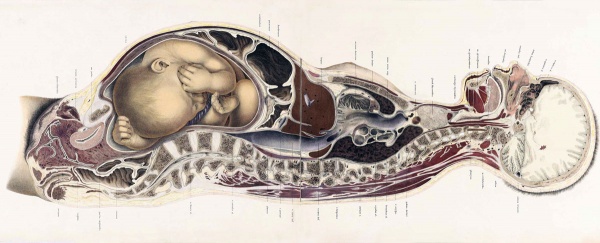

|
Students by definition are learning about a topic, so it would seem contrary to the function of an educational site to include information that may be either incorrect or inaccurate. On the other hand, I think it is also important to understand how we achieved our current understanding of embryology and the researchers, discoverers and educators who have made important contributions.
I therefore offer the following student study suggestions: Beginner | Intermediate | Advanced |
Beginner students
- You are just starting your studies and trying to understand basic embryology and development concepts.
Should probably avoid any content on the site labeled "Historic". The content may confuse or mislead your understanding of basic concepts in embryology and development. Begin with the notes pages linked from the image on the Main Page, or from the Site Map (excluding the history section of site).
Also be careful when viewing images and descriptions that appear as "additional images" or when using the "category" links at the bottom of pages.
Intermediate students
- You have a general understanding of embryology and development concepts.
This means you have attended some lectures and practical classes, worked through some of the site notes pages, or studied an embryology textbook. I would still suggest caution when approaching historic material, be sure that you understand the current embryology theories. General observations of how long development takes and the appearance of the human and animal models embryos at different times will not have changed!
Historic images are generally more accurate than some of the accompanying notes pages where the images appear. Some of the labeled structures may have historic names that have been updated or changed in current descriptions, if in doubt use the Glossary. You may also note how many of the textbook images have been based upon some of these historic drawing.
Advanced students
- You have a good understanding of embryology and development concepts.
This means that you not only understand, but can also explain clearly to others key developmental concepts. This also implies you understand the differences between recent findings, current controversies and research directions. Now is the time to confidently look back through the historic materials.
These historic materials will provide a context of how we arrived at our current understanding. Importantly, note the date on the page and consider what scientific techniques were available at that time and concurrent discoveries in biology and science.
How will I know that I am an advanced student? You should be able to identify concepts that remain and are applied today as well as those which have been updated or proved to be incorrect. Please also feel free to contact me with mistakes you have identified on this educational site.
Standing on the shoulders of giants.
Essays on the History of Embryology
A series of short paper published by Arthur William Meyer (1873 – 1966) between 1931 and 1932.
This series of essays by Arthur William Meyer published in the 1930's give an excellent overview of embryology through time.
Meyer AW. 1932 - Essays on the History of Embryology: Part I | Part II | Part III | Part IV | Part V | Part VI | Part VII | Part VIII | Part IX | Part X | Part XI | Arthur Meyer | Historic Embryology Papers
Needham J. A History of Embryology. (1959) Cambridge University Press, London.
Contributions to Embryology
- Contributions to Embryology - Carnegie Institution of Washington Series
A historic series of papers published by the Carnegie Institution of Washington early in the 20th Century.
Historic Textbooks
These historic textbooks are listed chronologically below.
Educational History of the Genitalia
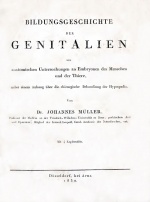
|
Educational History of the Genitalia of Anatomica Studies on Embryos of Humans and Animals By Johannes Müller (1850) |
A Study Of The Critical Period And Its Effects In Mammalia
Beard J. The span of gestation and the cause of birth - A study of the critical period and its effects in mammalia. (1897) Jena. Gustav Fischer, Leipzig.
A Very Young Ovum In Situ
Leopold G. A Very Young Ovum In Situ (1907) translated by Vogt WH. CV Mosby and Co. St Louis.
The Elements of Embryology
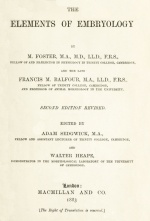
|
Volume 1 By Foster, M., Balfour, F. M., Sedgwick, A., & Heape, W. (1883) The History of the Chick: Egg structure and incubation beginning | Summary whole incubation | First day | Second day - first half | Second day - second half | Third day | Fourth day | Fifth day | Sixth day to incubation end | Appendix Volume 2 By Foster, M., Balfour, F. M., Sedgwick, A., & Heape, W. (1883) The History of the Mammalian Embryo: General Development | Embryonic Membranes and Yolk-Sac | Organs in Mammalia | Organs from Mesoblast | Alimentary Canal | Appendix | Figures |
Fathers of Biology
Fathers of Biology By Charles McRae (1890)
Text-Book of the Embryology of Man and Mammals
Ectopic Pregnancy
Webster, GJ. Ectopic Pregnancy - Its Etiology, Classification, Embryology, Diagnosis , and Treatment (1895)
A Critical Period in the Development of the Horse
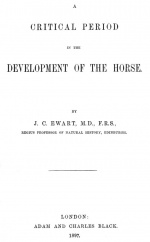
|
A Critical Period in the Development of the Horse
by Ewart, J.C. (1897) London: Adam and Charles Black. |
Human Embryology
Human Embryology and Morphology
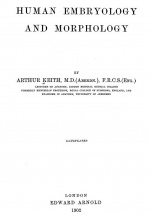
|
Human Embryology and Morphology by Arthur Keith (1902) first edn.
|
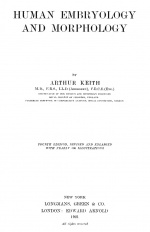
|
Human Embryology and Morphology by Arthur Keith (1921) fourth edn.
Human Embryology and Morphology: 1 Early Ovum and Embryo | 2 Connection between Foetus and Uterus | 3 Primitive Streak Notochord and Somites | 4 Age Changes | 5 Spinal Column and Back | 6 Body Segmentation | 7 Spinal Cord | 8 Mid- and Hind-Brains | 9 Fore-Brain | 10 Fore-Brain Cerebral Vesicles | 11 Cranium | 12 Face | 13 Teeth and Mastication | 14 Nasal and Olfactory | 15 Sense OF Sight | 16 Hearing | 17 Pharynx and Neck | 18 Tongue, Thyroid and Pharynx | 19 Organs of Digestion | 20 Circulatory System | 21 Circulatory System (continued) | 22 Respiratory System | 23 Urogenital System | 24 Urogenital System (Continued) | 25 Body Wall and Pelvic Floor | 26 Limb Buds | 27 Limbs | 28 Skin and Appendages | Figures |
The Embryology Anatomy and Histology of the Eye
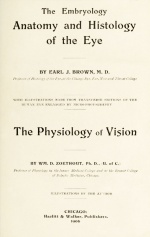
|
By Brown, E.J. (1906) The Embryology Anatomy and Histology of the Eye: Embryology | Anatomy | Histology | Figures |
A Text-book of Embryology
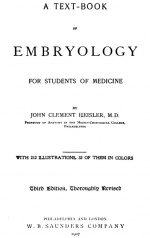
|
A Text-book of Embryology by John Clement Heisler (1907)
Heisler JC. A text-book of embryology for students of medicine. 3rd Edn. (1907) W.B. Saunders Co. London.
|
Atlas of the Development of Man (Vol 1 and 2)
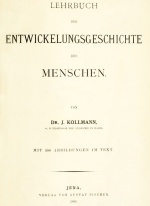
|
Handatlas der entwicklungsgeschichte des menschen By Kollmann, J. (1907) |
Contributions to the Study of the Early Development and Imbedding of the Human Ovum
|
Book - Contributions to the Study of the Early Development and Imbedding of the Human Ovum (1908) |
Normal Plates of the Development of Vertebrates
Normal Plates of the Development of Vertebrates series
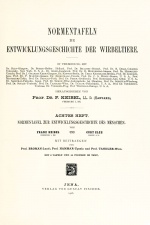
|
series editor Franz Keibel
|
Stoehr's Histology
Lewis, FT. Stoehr's Histology. (1906) P. Blakiston's Son & Co., Philadelphia.
Manual of Human Embryology
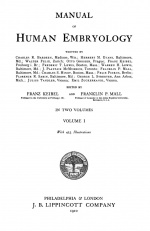
|
by Franz Keibel and Franklin P. Mall (1910)
| ||
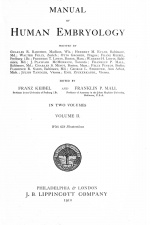
|
|
Vertebrate Embryology
By
J. W. Jenkinson (1913)
- Vertebrate Embryology 1913: 1 Introduction | 2 Growth | 3 The Germ-Cells, their Origin and Structure | 4 The Germ- Cells, their Maturation and Fertilization | 5 Segmentation | 6 The Germinal Layers | 7 The Early Stages in the Development of the Embryo | 8 The Foetal Membranes of the Mammalia | 9 The Placenta | Figures
Outlines of Chordate Development
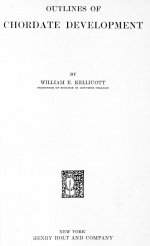
|
by Kellicott, W.E. (1913)
|
The Development of the Human Body - A Manual of Human Embryology
McMurrich JP. The Development Of The Human Body. (1914) P. Blakiston's Son & Co., Philadelphia, Pennsylvania.
The Development of the Albino Rat - Mus Norvegicus Albinus
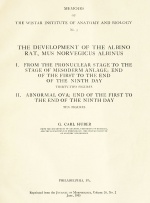
|
By G. Carl Huber
|
Contributions to the Development of the Human Brain
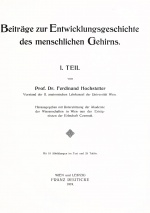
|
Beiträge zur Entwicklungsgeschichte des menschlichen Gehirns
By Ferdinand Hochstädter Contributions to the History of Development of the Human Brain |
Extra-uterine Pregnancy
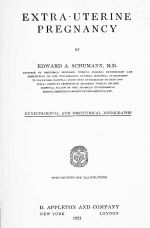
|
Schumann EA. Extra-uterine pregnancy (1921) D. Appleton And Company, New York London 1921. |
The Frog Its Reproduction and Development
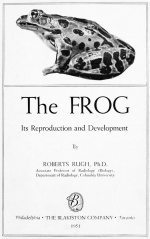
|
By Roberts Rugh, Ph.D.
|
A Laboratory Manual and Text-book of Embryology
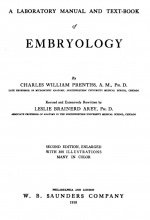
|
By Charles William Prentiss (1917)
Prentiss CW. and Arey LB. A laboratory manual and text-book of embryology. (1918) W.B. Saunders Company, Philadelphia and London.
|
The Early Embryology of the Chick
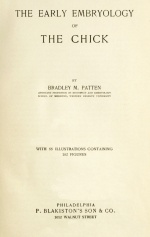
|
By Patten, B.M. (1920) The Early Embryology of the Chick: Introduction | Gametes and Fertilization | Segmentation | Entoderm | Primitive Streak and Mesoderm | Primitive Streak to Somites | 24 Hours | 24 to 33 Hours | 33 to 39 Hours | 40 to 50 Hours | Extra-embryonic Membranes | 50 to 55 Hours | Day 3 to 4 | References | Figures |
Text-Book of Embryology
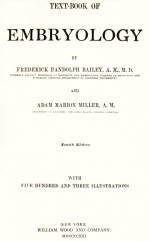
|
By Bailey, F.R. and Miller, A.M. (1921) Text-Book of Embryology: Germ cells | Maturation | Fertilization | Amphioxus | Frog | Chick | Mammalian | External body form | Connective tissues and skeletal | Vascular | Muscular | Alimentary tube and organs | Respiratory | Coelom, Diaphragm and Mesenteries | Urogenital | Integumentary | Nervous System | Special Sense | Foetal Membranes | Teratogenesis |
Human Embryology and Morphology
Human Embryology and Morphology by Arthur Keith (1921)
Note this textbook by Arthur Keith has the same name as his earlier 1902 edition Human Embryology and Morphology. This later edition incorporates new findings mainly from Mall and Keibel's work.
Congenital Cardiac Disease
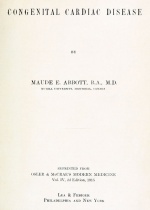
|
By Maude E. Abbott (1915) Congenital Cardiac Disease Philadelphia and New York: Lea & Febiger 1915.
Abbott ME. Congenital Cardiac Disease (1915) Osler & Mccrae's Modern Medicine 6, 2nd Edition.
|
The Eggs of Mammals
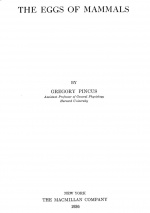
|
By Gregory Pincus (1936) The Eggs of Mammals New York, The Macmillan Company 1936.
Pincus G. The Eggs of Mammals. (1936) The Macmillan Company, New York.
The Eggs of Mammals
|
Anatomy of the Human Body
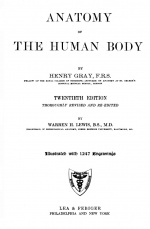
|
By Henry Gray (1918) Gray's Anatomy Philadelphia: Lea & Febiger, 1918.
|
Quain's Elements of Anatomy
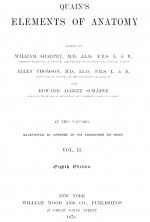
|
By Jones Quain Elements of Anatomy edited by Sharpey, Thompson and Schäfer 1878.
|
The Hormones in Human Reproduction
Corner GW. The Hormones in Human Reproduction. (1942) Princeton University Press.
Vertebrate Zoology
Vertebrate Zoology by G. R. de Beer (1928)
On the Origin of Species
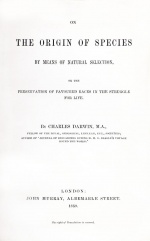
|
By Charles Darwin On the Origin of Species 1859.
|
Evolution and Genetics
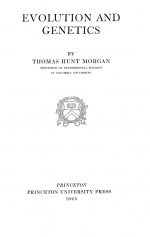
|
By Morgan, T. H. (1925). Evolution and genetics. Princeton: Princeton University Press.
|
Developmental Stages in Human Embryos
BY O'Rahilly, R. and Müller, F. (1987).
Carnegie Institution of Washington Publication 637.
- 1987 Stages: Introduction | 1 | 2 | 3 | 4 | 5 | 6 | 7 | 8 | 9 | 10 | 11 | 12 | 13 | 14 | 15 | 16 | 17 | 18 | 19 | 20 | 21 | 22 | 23 | References | Appendix 1 | Appendix 2 | Historic Papers | Embryonic Development
The Emergence of Experimental Embryology in the United States
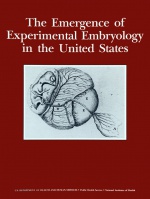
|
The Emergence of Experimental Embryology in the United States by S. Robert Hilfer, Ph.D. 1990. |
A History of Science
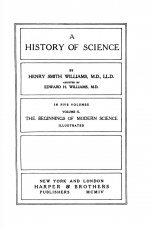
|
A History of Science by Henry Smith Williams, M.D., LL.D. assisted by Edward H. Williams, M.D. (1904) Arabian Medicine | Mediaeval Science in the West | The Great Anatomists | The coming of Harvey | Leeuwenhoek Discovers Bacteria | Medicine in the 16th and 17th Century | Philosopher-Scientists and new Institutions | 18th Century Anatomy and Physiology Part 1 | 18th Century Anatomy and Physiology Part 2 | 18th Century Anatomy and Physiology Part 3 | 19th Century Anatomy and Physiology Part 1 | 19th Century Anatomy and Physiology Part 2 | 19th Century Anatomy and Physiology Part 3 | Theories Of Evolution Part 1 | Theories Of Evolution Part 2 | 18th Century Medicine | 19th Century Medicine Part 1 | 19th Century Medicine Part 2 | Brain and Mind | Brain Structure
|
Historic Journals
Some of the historic journals listed below are continuing to be published today.
Journal of Anatomy
The Journal of Anatomy is an international peer-reviewed journal sponsored by the Anatomical Society (UK). It was originally published (1867 to 1916) as J Anatomy and Physiology and from 1916 became the Journal of Anatomy.
American Journal of Anatomy
| Amer. J Anat.: 1 - 1901-02 | 2 - 1902-03 | 3 - 1904 | 4 - 1905 | 5 - 1906 | 6 - 1906-07 | 7 - 1907-08 | 8 - 1908 | 9 - 1909 | 10 - 1910 | 11 - 1910-11 | 12 - 1911-12 | 13 - 1912 | 14 - 1912-13 | 15 - 1913-14 | 16 - 1914 | 17 - 1914-15 | 18 - 1915 | 19 - 1916 | 20 - 1916 | 21 - 1917 | 22 - 1917 | 23 - 1918 | 25 - 1919 | 26 - 1919-20 | 27 - 1920 | 28 - 1920-21 | 29 - 1921 | 30 - 1922 | |
| |
The Anatomical Record
| Anat. Rec.: 1 - 1906-08 | 2 - 1908 | 3 - 1909 | 4 - 1910 | 5 - 1911 | 6 - 1912 | 7 - 1913 | 8 - 1914 | 9 - 1915 | 10 - 1915-16 | 11 - 1917 | 12 - 1917 | 13 - 1917 | 14 - 1918 | 15 - 1918-19 | 16 - 1919 | 17 - 1919 | 18 - 1920 | 19 - 1920 | 21-22 - 1921 | 23-24 - 1922 | |
| |
|
Journal of Morphology
| J Morphol. : 1 - 1887 | 2 - 1888-89 | 3 - 1889 | 4 - 1890 | 5 - 1891 | 6 - 1892 | 7 - 1892 | 8 - 1893 | 9 - 1894 | 10 - 1895 | 11 - 1895 | 12 - 1896 | 13 - 1897 | 14 - 1897-98 | 15 - 1898 | 16 - 1899-1900 | 17 - 1901 | 18 - 1903 | 19 - 1908 | 20 - 1909 | 21 - 1910 | 22 - 1911 | 23 - 1912 | 24 - 1913 | 25 - 1914 | 26 - 1915 | 27 - 1916 | 28 - 1916-17 | 29 - 1917 | 30 - 1917-18 | 31 - 1918 | 32 - 1918 | 33 - 1919-20 | 34 - 1920 | 35 - 1921 | 36 - 1921-22 | 40 - 1928 | 47 - 1929 | 51 - 1931 | 52 - 1931 | | |
| |
The Johns Hopkins Medical Journal
Historic Papers
See new page - Historic Embryology Papers
| More Historic Papers |
|---|
|
- Historic Paper Links: 13-14 Somites | 22 Somites | 23 Somites | 25 Somites | 27 Somites | Mall Human Embryo Collection | Embryology History | Carnegie stage 11 | Carnegie stage 12 | Journal of Anatomy | Embryonic Development | Category:Historic Embryology
Timeline
Long Ago
- Aristotle (384 – 322 BC) Greek philosopher and scientist De generatione animalium (On the Generation of Animals).
- Arabian Medicine
- Mediaeval Science in the West
- The Great Anatomists
- Gabriel Fallopius (1523-1562) - Fallopian tube (uterine tube, uterine horn) named after.
- Francesco Redi (1626-1698) - refutes " spontaneous generation" by showing origin of insects within decaying matter.
- The coming of Harvey
- Leeuwenhoek Discovers Bacteria
- Medicine in the 16th and 17th Century
- Philosopher-Scientists and new Institutions
- 17th and 18th Century Anatomies
1626 Spiegel and Casseri: De formato foetu liber singularis (1626) Adriaan van den Spiegel (1578-1625) Published posthumously by Spigelius' son-in-law, the physician Liberalis L. Crema of Padua.
1668 Regnier de Graaf (1641 - 1673), a Dutch physician and anatomist. Doctoral thesis on the pancreas, identified the function of the ovarian follicle (named Graafian follicle), the final mature antral follicle released by ovulation.
- De Graaf R. De virorum organis generationi inservientibus, de clysteribus et de usu siphonis in anatomia. Ex officina Hackiana, Lugd. Batav. et Roterod. 1668.
- De Graaf R. De mulierum organis generationi inservientibus tractatus novus. Ex officina Hackiana, Lugd. Batav. 1672.
- R. De Graaf. Alle de wercken, Abraham Abrahamse, Amsterdam (1686).
References:
- Houtzager HL. Reinier De Graaf and his contribution to reproductive biology. Eur J Obstet Gynecol Reprod Biol. 2000 Jun;90(2):125-7. No abstract available.
- Jay V. A portrait in history. The legacy of Reinier de Graaf. Arch Pathol Lab Med. 2000 Aug;124(8):1115-6. No abstract available.
- Setchell BP. The contributions of Regnier de Graaf to reproductive biology. Eur J Obstet Gynecol Reprod Biol. 1974;4(1):1-13. No abstract available.
- Wiesemann C. [Regnier de Graaf (1641-1673)] Pathologe. 1991 Nov;12(6):352-3. German. No abstract available.
- Mann RJ. Regnier de Graaf, 1641-1673, investigator. Fertil Steril. 1976 Apr;27(4):466-8. No abstract available.
- Modlin IM. Regnier de Graaf: Paris, purging, and the pancreas. J Clin Gastroenterol. 2000 Mar;30(2):109-13. No abstract available.
1690 Bidloo, Govard (1649 - 1713) Ontleding des menschelyken lichaams, Amsterdam: By de weduwe van Joannes van Someren, de erfgenaamen van Joannes van Dyk, Hendrik en de weduwe van Dirk Boom, 1690. (More? NLM - Historical Anatomies)
18th Century
- 18th Century Anatomy and Physiology Part 1 | 18th Century Anatomy and Physiology Part 2 | 18th Century Anatomy and Physiology Part 3
- 18th Century Medicine
- 17th and 18th Century Anatomies
1705 "Paul Portal (1630-1703), The Compleat Practice of Men and Women Midwives (1705). A French obstetrician, originally published this important treatise in Paris in 1696. It includes his demonstration of turning a fetus during childbirth using one foot and contains his teaching that face presentation runs a normal course during the labor process." (More? Historical Medical Digital Library)
1754 William Smellie: A sett of anatomical tables, with explanations, and an abridgment, of the practice of midwifery (1754). He also helped develop the delivery forceps which by the late eighteenth century were a well-known standard obstetrical instrument. (More? NLM - Historical Anatomies)
1774 William Hunter (1718-1783) Anatomia uteri humani gravidi tabulis illustrata = The anatomy of the human gravid uterus exhibited in figures (1774). Caspar Friedrich Wolff (1733-1794) Theoria Generationis new theory of epigenesis, the gradual building up of embryonic structures, countered the existing theory of preformation.
1770 - 1775 A series of models commissioned by Giuseppe Galletti (? - 1819) currently held in the Institute and Museum of the History of Science (Italy) Istituto e Museo di Storia della Scienza (IMSS). Giuseppe Galletti and others used terracotta and wax models that he had commissioned in Florence between 1770 and 1775 to train surgeons and midwives. Week 10 Fetus Model | Week 16 Fetus Model | Week 24 Fetus Model | Stage 1 Terracotta Model 1 | Stage 1 Terracotta Model 2 | Stage 1 Wax Model | Breech Birth 1 | Breech Birth 2 | Breech Birth 3 | Breech Birth Wax Model | Placenta Previa | Category:Galletti1770
Institute and Museum of the History of Science "Specimens of obstetric models: the wax models are life-sized; the terracotta versions are reduced to a 1:3 scale. Together with the anatomical waxes in the Specola Museum in Florence, these models are among the most significant examples of the use of artistic techniques for teaching medicine and obstetrics to midwives and surgery students in Florentine hospitals at the end of the eighteenth century."
19th Century
- 19th Century Anatomy and Physiology Part 1 | 19th Century Anatomy and Physiology Part 2 | 19th Century Anatomy and Physiology Part 3
- Theories Of Evolution Part 1 | Theories Of Evolution Part 2
- 19th Century Medicine Part 1 | 19th Century Medicine Part 2
- Brain and Mind | Brain Structure
1824 - Rolando cut chemically hardened (fixed) pieces of brain tissues into thin sections for microscopical examination.
1851 - Prize Essay on the Corpus Luteum
1859 Evolution Darwin
1867 Braune, Wilhelm (1831-1892): Topographisch-anatomischer Atlas : nach Durchschnitten an gefrornen Cadavern, Leipzig: Verlag von Veit & Comp., 1867-1872. (Topographic-anatomical Atlas)
1879 The Morphology of the Vertebrate Olfactory Organ.
1880 - image excerpts from a historic study of German embryologist Wilhelm His (1831-1904) Anatomie menschlicher Embryonen (1880).
Leydig cells named after german zoologist Franz von Leydig (1821 - 1908).
1883 - Michael Foster textbook on chicken development The Elements of Embryology - Volume 1 The History of the Chick: Egg structure and incubation beginning | Summary whole incubation | First day | Second day - first half | Second day - second half | Third day | Fourth day | Fifth day | Sixth day to incubation end
1887 - W. H. Caldwell The Embryology of Monotremata and Marsupialia Part I.
1889 - Camille Golgi discovered a method of silver staining hardened brain tissues.
- Charles Minot Uterus And Embryo (1889) - I. Rabbit II. Man
1892 - Franklin Mall Paper - A Human Embryo Twenty-Six Days Old
1892 - Oscar Hertwig Text-Book of the Embryology of Man and Mammals
Early 20th Century
1906 - Earl J. Brown textbook on The Embryology Anatomy and Histology of the Eye.
1906 - Albert Gray article Observations on the Labyrinth of Certain Animals
1907 - Peter Thompson article Description of a Human Embryo of Twenty-three Paired Somites[3]
1908 - Alexander Low article Description of a Human Embryo of 13-14 Mesodermic Somites[4]
1914 - image excerpts from a historic study of The Anatomy of a 17.8 mm Human Embryo by Thyng, FW 1914.
1914 - Observations upon Young Human Embryos Wilson JT. J Anat Physiol. 1914 Apr;48(Pt 3):315-51.[5]
1916 - The Typical Form of the Cochlea and its Variations Watt. H.J.
1917 - "On Growth and Form" D’Arcy Wentworth Thompson (1860-1948) publishes this book on the application of mathematics to growth in nature.
1918 - links to images from the historic textbook Anatomy of the Human Body by Henry Gray.
1935 - Hans Spemann Nobel Prize in Medicine.
1920 - Bradley M. Patten textbook on The Early Embryology of the Chick.
1921 - Bailey, F.R. and Miller, A.M. Text-Book of Embryology.
1928 - Aschheim, S., and Zondek, B. Introduce first hormone based test for pregnancy.
1937 - West CM. A human embryo of twenty-five somites. (1937) J. Anat., 71(2): 169-200.1. PMID 17104635 A Human Embryo of Twenty-five Somites[6]
1941 - Dible, JH and West CM A Human Ovum at the Previllous Stage[7]
1949 - Morton WRM. Two early human embryos. (1949) J. Anat., 83: 308-314. Two early human embryos.
1951 - Patten BM. Embryology of the Pig. (1951) The Blakiston Company, Toronto.
Development in the early 20th century can also be seen in some Historic Movies 1920-1960.
Late 20th Century
Much of the modern history of Medicine/Embryology is documented in the Nobel Prizes for Medicine. There are either text extracts included or links to external texts or references in these notes. Some key women in development Virginia Apgar and Nicole Le Douarin.
1951 - Dr Viktor Hamburger and H L Hamilton publish "A series of normal stages in the development of the chick embryo."
1953 - Apgar test - historic neonatal test designed by Dr Virginia Apgar.
1965 - Neural Crest Research Nicole Le Douarin.
1978 - First IVF baby born (The Nobel Prize in Physiology or Medicine 2010 Awarded to Robert G. Edwards "for the development of in vitro fertilization")
1996 - "Dolly the sheep" First adult somatic cell cloning using the process of nuclear transfer.
Nobel Prizes
Much of the modern history of Medicine/Embryology is documented in the Nobel Prizes for Medicine. Remember that these award dates reflect findings that have proven to be scientific key breakthroughs from earlier dates.
21st Century
2000 - Human Genome Complete
2001 talk given by Robert Winston "Engineering Reproduction: Will We Still Be Human At The End of the 21st Century".
Nobel Prizes
Much of the modern history of Medicine/Embryology is documented in the Nobel Prizes for Medicine. Remember that these award dates reflect findings that have proven to be scientific key breakthroughs from earlier dates.
- 2002 cell cycle
- 2002 cell death
- 2007 embryonic stem cells Stem Cells
- 2010 - Development of in vitro fertilization (IVF) Awarded to Robert G. Edwards Assisted Reproductive Technology | Nobel Prize 2010)
- 2012 - induced stem cells Discovery that mature cells can be reprogrammed to become pluripotent awarded jointly to Sir John B. Gurdon and Shinya Yamanaka Stem Cells
Also see other History of Medicine Resources, particularly Dr. Ian Carr's brief paper on The History of Childbirth, and Neonatology on the Web has a long list of historic Classic Papers in Neonatal Medicine.
History - Models
Galletti Models
(late 18th century)
|
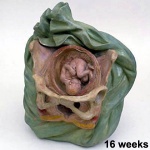
|
Ziegler Models
(19th to early 20th century)
Ziegler Freiburg workshop (c 1912). Ziegler Models | Embryology Models
| Ziegler Models (1860's - ) | |||
|---|---|---|---|
|
Carnegie Models
| Osborne O. Heard (1891–1983) produced over 700 wax-based embryo reconstructions models for the Carnegie Institute.
Models were produced by the lost-wax casting process and were more detailed than the earlier Ziegler (1880's) embryo models.
|
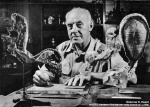
|
Blechschmidt Models
| Blechschmidt Models
Erich Blechschmidt (1904–92) independently developed new methods of embryo reconstruction, 200,000 serial sections of embryos and 64 models. (University of Goettingen, Germany)
|
History - People
| Embryologists: William Hunter | Wilhelm Roux | Caspar Wolff | Wilhelm His | Oscar Hertwig | Julius Kollmann | Hans Spemann | Francis Balfour | Charles Minot | Ambrosius Hubrecht | Charles Bardeen | Franz Keibel | Franklin Mall | Florence Sabin | George Streeter | George Corner | James Hill | Jan Florian | Thomas Bryce | Thomas Morgan | Ernest Frazer | Francisco Orts-Llorca | José Doménech Mateu | Frederic Lewis | Arthur Meyer | Robert Meyer | Erich Blechschmidt | Klaus Hinrichsen | Hideo Nishimura | Arthur Hertig | John Rock | Viktor Hamburger | Mary Lyon | Nicole Le Douarin | Robert Winston | Fabiola Müller | Ronan O'Rahilly | Robert Edwards | John Gurdon | Shinya Yamanaka | Embryology History | Category:People | ||
|
- Embryology History - William Hunter
- Embryology History - Wilhelm His
- Franklin Mall
- Embryology History - Santiago Ramón y Cajal
- Embryology History - Hans Spemann
- Embryology History - Nicole Le Douarin
- Embryology History - Robert Winston
Embryology Textbooks
Most Textbooks include Embryology Historic issues in the preface, opening chapter or within each chapter as a special section or highlighted text box. Therefore no specific chapter or page reference is shown for the texts below.
- Human Embryology (2nd ed.) Larson
- The Developing Human: Clinically Oriented Embryology (6th ed.) Moore and Persaud
- Before we Are Born (5th ed.) Moore and Persaud
- Essentials of Human Embryology Larson
- Fitzgerald
- Links: Embryology Textbooks
Nobel awards in Medicine
- The Nobel Prize Homepage has a searchable database and an annual table of awards.
- The Nobel Prize in Physiology or Medicine 2002 - discoveries concerning 'genetic regulation of organ development and programmed cell death' Summary: "The human body consists of hundreds of cell types, all originating from the fertilized egg. During the embryonic and foetal periods, the number of cells increase dramatically. The cells mature and become specialized to form the various tissues and organs of the body. Large numbers of cells are formed also in the adult body. In parallel with this generation of new cells, cell death is a normal process, both in the foetus and adult, to maintain the appropriate number of cells in the tissues. This delicate, controlled elimination of cells is called programmed cell death."
- The discovery of Hox genes and other genes related to body pattern formation. The fly Antennapedia mutant during development the embryo incorrectly positions two legs (pedia) where antenna should have been positioned. The discovery of this mutant in opened up the field of developmental genes and this field has recently (1995) been rewarded with a Nobel prize in Medicine. See also Fly Development
- Award Details: "for their discoveries concerning the genetic control of early embryonic development"
- LEWIS, EDWARD B., U.S.A., California Institute of Technology, Pasadena, CA, U.S.A., 1918
- NUSSLEIN-VOLHARD, CHRISTIANE, Germany, Max-Planck-Institut für Entwicklungsbiologie, Tubingen, Germany, 1942
- WIESCHAUS, ERIC F., U.S.A., Princeton University, Princeton, NJ, U.S.A., * 1947
References
- ↑ Pritchard, U. The Cochlea of the Ornithorhynchus platypus compared with that of ordinary Mammals and of Birds Proceedings of the Royal Society of London (1854-1905). (January 1, 1880) 31:149–153.
- ↑ <pubmed>17232695</pubmed>| PMC1287457
- ↑ Thompson P. (1907). Description of a Human Embryo of Twenty-Three Paired Somites. J Anat Physiol , 41, 159-71. PMID: 17232726
- ↑ Low A. (1908). Description of a Human Embryo of 13-14 Mesodermic Somites. J Anat Physiol , 42, 237-51. PMID: 17232769
- ↑ Wilson JT. (1914). Observations upon Young Human Embryos. J Anat Physiol , 48, 315-51. PMID: 17233002
- ↑ <pubmed>17104635</pubmed>| PMC1252340
- ↑ <pubmed>17104860</pubmed>
Articles
<pubmed>11417885</pubmed> <pubmed>9260153</pubmed> <pubmed>8850558</pubmed> <pubmed>8735912</pubmed> <pubmed>9007209</pubmed> <pubmed>9511981</pubmed> <pubmed>9949997</pubmed> <pubmed>9284643</pubmed> <pubmed>8921131</pubmed> <pubmed>8735920</pubmed> <pubmed>8735918</pubmed> <pubmed>8735910</pubmed> <pubmed>7669542</pubmed> <pubmed>9061232</pubmed> <pubmed>7981025</pubmed> <pubmed>7981024</pubmed> <pubmed>8153264</pubmed> <pubmed>1478173</pubmed> <pubmed>1627471</pubmed> <pubmed>1627468</pubmed> <pubmed>1502140</pubmed> <pubmed>1804216</pubmed> <pubmed>1804214</pubmed> <pubmed>1804212</pubmed>
Search Pubmed
August 2010 "Embryology history" All (5271) Review (756) Free Full Text (799)
Search Pubmed: Embryology history
External Links
External Links Notice - The dynamic nature of the internet may mean that some of these listed links may no longer function. If the link no longer works search the web with the link text or name. Links to any external commercial sites are provided for information purposes only and should never be considered an endorsement. UNSW Embryology is provided as an educational resource with no clinical information or commercial affiliation.
- Hippocrates on the Web
- Faculty of Medicine of the University of Manitoba. Histories of Medicine on the web by Manitoba Authors | DYING TO HAVE A BABY - THE HISTORY OF CHILDBIRTH by Dr. Ian Carr, Professor of Pathology
- Hannah Chair, History of Medicine, Queen's University
- Karolinska Institute- History of Biomedicine
- MEDICAL HISTORY ON THE INTERNET
- Wellcome Institute for the History of Medicine
- WWW Virtual Library - History of Medicine
- Antique Medical Instruments- Vanderbilt University Medical Center.
- Online Microscopes
- Neonatology on the Web | Classic Papers in Neonatal Medicine- (A large list of historic texts available online) | An Essay upon Nursing and the Management of Children, from their Birth to Three Years of Age, Third Edition, by William Cadogan, 1749.
Glossary Links
- Glossary: A | B | C | D | E | F | G | H | I | J | K | L | M | N | O | P | Q | R | S | T | U | V | W | X | Y | Z | Numbers | Symbols | Term Link
Cite this page: Hill, M.A. (2024, April 24) Embryology Embryology History. Retrieved from https://embryology.med.unsw.edu.au/embryology/index.php/Embryology_History
- © Dr Mark Hill 2024, UNSW Embryology ISBN: 978 0 7334 2609 4 - UNSW CRICOS Provider Code No. 00098G

